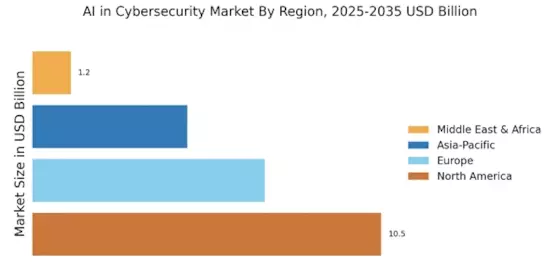The AI in Cybersecurity Market is currently characterized by a dynamic competitive landscape, driven by the increasing sophistication of cyber threats and the growing demand for advanced security solutions. Major players such as CrowdStrike (US), Palo Alto Networks (US), and Darktrace (GB) are at the forefront, each adopting distinct strategies to enhance their market positioning. CrowdStrike (US) emphasizes innovation through its cloud-native Falcon platform, which integrates AI and machine learning to provide real-time threat detection and response. Meanwhile, Palo Alto Networks (US) focuses on expanding its portfolio through strategic acquisitions, enhancing its capabilities in AI-driven security solutions. Darktrace (GB), on the other hand, leverages its self-learning AI technology to autonomously detect and respond to cyber threats, positioning itself as a leader in proactive cybersecurity measures. Collectively, these strategies contribute to a competitive environment that is increasingly reliant on technological advancement and strategic partnerships.
In terms of business tactics, companies are increasingly localizing their operations and optimizing supply chains to enhance responsiveness to regional market demands. The market structure appears moderately fragmented, with a mix of established players and emerging startups vying for market share. The collective influence of key players is significant, as they not only set industry standards but also drive innovation through competitive pressures.
In August 2025, CrowdStrike (US) announced a partnership with a leading cloud service provider to enhance its AI capabilities, allowing for deeper integration of threat intelligence across platforms. This strategic move is likely to bolster CrowdStrike's position in the market by providing customers with more comprehensive security solutions that leverage cloud technology. The partnership underscores the importance of collaboration in addressing the evolving landscape of cyber threats.
In September 2025, Palo Alto Networks (US) completed the acquisition of a prominent AI startup specializing in predictive analytics for cybersecurity. This acquisition is expected to enhance Palo Alto's existing offerings by integrating advanced predictive capabilities, thereby improving threat detection and response times. Such strategic actions reflect a broader trend of consolidation within the industry, as companies seek to enhance their technological prowess through mergers and acquisitions.
In July 2025, Darktrace (GB) launched a new AI-driven product aimed at small and medium-sized enterprises (SMEs), which are often more vulnerable to cyber threats. This initiative not only expands Darktrace's market reach but also demonstrates its commitment to democratizing access to advanced cybersecurity solutions. By targeting SMEs, Darktrace positions itself to capture a growing segment of the market that requires robust yet affordable security measures.
As of October 2025, the competitive trends in the AI in Cybersecurity Market are increasingly defined by digitalization, sustainability, and the integration of AI technologies. Strategic alliances are becoming more prevalent, as companies recognize the need for collaborative approaches to tackle complex cybersecurity challenges. Looking ahead, competitive differentiation is likely to evolve, shifting from traditional price-based competition to a focus on innovation, technological advancement, and supply chain reliability. This transition suggests that companies that prioritize these elements will be better positioned to thrive in an increasingly competitive landscape.


















Leave a Comment